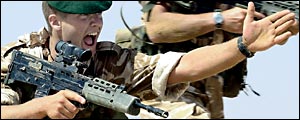Canada is treating its soldiers disgracefully. The fighting in Afghanistan is not a gentlemen’s game between sportsmen, it is a fight to the death with desperate terrorists. If some dead Al Qaeda/Taliban soldier was posed for a photograph with a cigarette and a placard around his neck saying ‘fuck terrorism’ then I say so what? It is okay to kill a man, to blow a hole in his body with a 50 cal slug, to shoot him dead, at the behest of your government… but not to disrespect the terrorist supporting son of a bitch’s corpse? Ludicrous.
|
|||||
|
I sometimes find myself agreeing with Steven Den Beste’s articles but sorry Steven, this is one of the dumbest pieces you have written in a while. When he is right, he is sometimes very right and when he is wrong, he does tend to descend into crude history-by-Hollywood-stereotype. The picture he displays of two Royal Marines sparing with boxing gloves and an automatic weapon toting US soldier in the background is indeed symbolic… of the fact Steven does not know the slightest thing about modern British attitudes to war, British military culture or British military history.
People would think Britain had not won a war in the last 100 years if they got their history by reading what Steven writes, let alone in 1982. The Germans, Austrians, Argentines, Malays, Indonesians, Kenyans, Irish, Italians, French, Turks, Greeks, Japanese, Afghans etc. etc. etc. probably have a rather different take on British military culture. There is a reason Britain won in Malaya during The Emergency and the US lost in Vietnam under similar conditions. Marquis of Queensbury? Get real. Here is a picture I think rather better sums up Britain’s ‘Red and Green War Machine’  Update: Finally I have found a way to mention a subject related to what I try to do for living, in a way relevant to libertarians and like-minded netwarriors. I have been interested in networks and their security for some time but only recently I have begun to notice articles and books attempting to analyse the implications of technology and information age on networks at a more strategic level. (I am not saying that they did not exist, simply that I haven’t been able to reach them despite my continuous searches). Perhaps it is a result of the very network effect that the topic is attracting more attention as it spreads into more industries, areas and levels of society. And so I have come across a book titled Networks and Netwars: The Future of Terror, Crime and Militancy published by RAND (a contraction of the term Research and Development), the first organisation to be called a “think tank”. The authors take as a given that the fight for the future is not between the armies of leading states, nor are its weapons those of conventional armed forces. What today’s combatants – whether it be terrorist groups like Al Qaeda, drug smuggling cartels of Columbia and Mexico, or non-violent, civil-society activists for environment, human rights or liberty – have in common is that they operate in small, dispersed units that can deploy anytime, anywhere. They all feature network forms of organisation, doctrine, strategy and technology attuned to the information age. This gives rise to a new spectrum of conflict that has been termed netwars. Netwar is the lower-intensity, society rather than state based counterpart to the mostly military concept of cyberwar and its distinguishing features are: a) a dual nature – conflicts waged, on the one hand, by terrorists, criminals and ethno-nationalist extremists; and by civil-society activists on the other. The framework for assessing such networks looks at five levels: the technological, social, narrative, organisational and doctrinal. All five must be right for the network to be fully effective. (Perry, I hope you are taking notes. The technological sophistication is not the only thing that matters. The other levels have as much, if not more, effect on the potential power of the group. The social basis for co-operation is important for establishing trust and identity, for example among the members of ethnically based terror and crime groups. Among civil-society netwarriors, in the absence of the ethnic or social ties the narrative level matters most as sharing and projecting a common story empowers them and attracts audiences. Finally, the defining level of a netwar actor is the kind of network and the sort of doctrine he uses. To confront and cope with networked adversary, the same framework must be used to assess his strengths and weaknesses. The most serious opponents are highly networked and flexible, backed by social ties, secure communications and a common story about why they are together and what they need to do. The network form of organisation is a serious challenge to nation states because it strains their ability to cope with the threats posed by such non-state actors, especially if used for criminal or terrorist objectives. Strategists and policy makers in Washington and elsewhere have already noted this dark side of the netwar phenomenon. The book recommends that whilst they continue to keep an eye on the perils posed by the ‘bad guys’, they must form coalitions between states and civil society’s networked actors. I imagine if they follow this suggestion, there will perhaps be a link, in the appropriate category, to the U.S. Department of Defense on the side bar. Or vice versa. I’ve just read this Opinion Journal review of a new Mel Gibson movie and it sounds like a “must see”. I do find myself of two minds on the tenor of the article. It says some things which I fervently agree with:
There is no reason why one cannot simultaneously respect the valour and ability of the men who fought in Somalia against incredible odds while simultaneously disagreeing they should have been sent there in the first place. Where I part ways from the reviewer is on Vietnam. Where I see no difference betwixt the two – honourable men doing the best they can at the behest of dishonourable and incompetent politicians – the reviewer apparently believes Vietnam served some sort of purpose. I lived through the time. I saw no point to it then and 30 years on I still don’t. This is a dichotomy never to be bridged in this life. But perhaps we can all make peace amongst ourselves by settling on something we can agree on. Those who fought in Vietnam were decent, brave and honourable men who deserved more respect than they received. I was on the phone this afternoon with an old Manhattan customer of mine. As long time readers of Samizdata know, I’ve spent a considerable amount of time working in Midtown and lived in the Lower East Side while on the job. I even did jobs in the WTC, and in fact just heard today one of the hotel staff I dealt with on a cybercast was last seen making certain people were evacuated. In any event… my consultancy customer base in New York went down the crapper along with the DotCrash so I’ve not had any jobs there since summer 2000. The call lasted nearly an hour. We discussed the possibilities, some of which would require I once again spend considerable time on the left shore of the Atlantic. I suggested further negotiations go through my Financial Director – her family is from Cavan so she knows how to bargain. Afterwards I was in quite good form, thinking about getting back to my old haunts, looking up the friends in the trad scene there… and then I read this. The 10kt weapon which the Drudge Report mentions is in the size range of the missing Russian ones I discussed earlier today. If al Qaeda do have one, and if they do use it… may Almighty God have mercy on their souls. Because we will not. The Drudge link looks rather generic, so if the content should change, this is the info to search for: Sun March 03, 2002 09:22:37 ET, October Bulletin Said Terrorists Thought To Have 10 Kiloton Nuclear Weapon To Be Smuggled Into New York City There is an interesting article “Nuke Nerves” over at Jeff Jarvis’ blog today. Unfortuneately he doesn’t seem to have easily extractable links so you’ll just have to search. What grabbed my attention was this “Sum of All (my) Fears” line from the Washington Post:
I mentioned once before, perhaps as far back as October, my worries about several Russian tactical nukes reported missing by a UK newspaper feature article in the early ’90’s. It may have been the Telegraph but it is so long ago I simply do not remember. I do remember discussing it with General Daniel O. Graham of the High Frontier Society at an International Space Development Conference in Washington DC in May 1992. Anyone who has access to the appropriate archives can thus limit their search to the period between September 1989 and May 1992. The point of the article was that 2-3 advanced low yield Russian tactical nuclear weapons, artillery shells I believe, were unaccounted for. Iran was believed to have acquired them. I have heard not a peep about this story in the last 10 years. As Sandline International proved in Sierra Leon once when they dramatically improved the security situation before their good work was largely undone by the amoral drones in the British Foreign and Commonwealth Office, private military organisations can be a valuable and stabilizing factor in many parts of the world. It is interesting that there are progressive elements in the British government who see this. Not surprisingly many socialist Labour MPs are horrified at the thought of non-state owned military formations even existing, as if somehow only being a state makes the use of force moral. Yet if the 20th century showed anything, it is that nations are far more likely to use force to murder their own citizens than to fight foreign wars. Third world armies in particular are notorious for endemic human rights abuses and rather than protecting the societies that fund them, in fact pose the primary threat to them. Highly professional modern mercenary outfits could give many small nations the best of both worlds: first world capabilities without third world problems. Also the hiring nation is not forced into being a neo-colonial supplicant that results from accepting British, American or (particularly) French military ‘assistance’. Similarly for countries like Britain or the US to contract out certain military operations is not just a return to practices that were common in the 19th century but give more ‘casualty sensitive’ nations like the US a good way to bring stability without making worthy objectives hostage to opportunist politicians looking to boost their exposure with every returning flag draped coffin. Companies like Sandline and Executive Outcomes are almost certainly the face of low intensity warfare in the future regardless of short term opposition because they make such eminent sense.  In a recent interview General Norman Schwarzkopf was asked if he thought there was room for forgiveness – towards the people who has aided and abetted the terrorists who had perpetrated the September 11th attacks on the United States. He said: “I believe that forgiving them is God’s function. Our job is simply to arrange the meeting.” Over on the excellent blog Flit, Bruce has done a good ‘back of the envelop’ bombing survey that highlights some interesting facets of ‘smart’ bombing vs. ‘dumb’ bombing vs. ‘real indiscriminate’ bombing (i.e Al Qaeda). The article pointing to Bruce’s survey “U.S. Aerial bombing: a statistical summary” provides a simple interpretation of what the numbers mean. This sort of short but thoughtful factually based commentary really does the blogosphere credit and is an excellent example of high quality original content blogging. It appears that US soldiers being sent to the Philippines to fight against Islamic Abu Sayyaf guerillas are welcome to clean up that nation’s mess and possibly get killed doing so, but only if they are kept away from local ‘sex workers’ (remember when they were called prostitutes?). As the commanding officer of the US troops must look after his men’s morale, he should march up to Philippines President Gloria Arroyo, hand her a packet of condoms and a Koran, followed by the single word: “Choose”. Like so many nation states, it appears the Philippines thinks it actually owns the bodies of its subject-citizens and who they may freely associate with. The cast of characters at DOD briefings has been a great relief after years of mealy mouthed morons who went pale at the thought of admitting their job was to defend their country by letting the other side die for their country as quickly as possible. I had a particular chuckle over the following from the 11th December 2001 DOD News Briefing.
I wonder if they break into laughter as soon as they leave the press behind in the briefing room? Personally I’d be near pissing myself as soon as the door closed. |
|||||

All content on this website (including text, photographs, audio files, and any other original works), unless otherwise noted, is licensed under a Creative Commons License. |
|||||
 )
)

